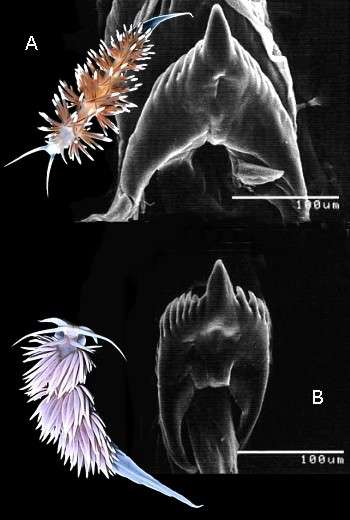
Radular teeth - differences in two related species
PHOTO
Animal and radular tooth of
A, Sakuraeolis gerberina.
B, Sakuraeolis sakuracea.
PHOTOS: Yoshi Hirano.
A recent paper (Hirano, 1999) shows how, in some cases, the shape of the radular teeth can solve a taxonomic puzzle.
In Japan, two aeolid species with quite different color patterns (Sakuraeolis gerberina and Sakuraeolis sakuracea, have been previously identified as one species, Sakuraeolis modesta (Bergh).
When alive, the two species are easily distinguishable by their distinct coloration. Hirano states that identification was even possible underwater with small individuals of about 10 mm in length. On the other hand, when they are preserved and the colour gone they are very difficult to separate. As is shown elsewhere in the Forum, reproductive differences are often the most important characters available to differentiate aeolid species. However in this case, the reproductive system is identical. Fortunately, as you can see in the photos, the shape and size of the radular teeth are quite distinctively different.
As Yoshi Hirano shows, the reason the identity of these two species has been confused for so long is that when they were first studied, (Baba,1949), he did not realise that the preserved material he was working on was a mix of two species. As luck would have it, the colour painting accompanying the material was of S. gerberina while the specimen he removed the radula from was S. sakuracea. In the preserved state, both species look almost identical.
This example well illustrates the value of the radula as a taxonomic tool, and the dangers of working with inadequately documented preserved material.
Reference: Hirano, Y.J. (1999) Two new species of Sakuraeolis from Japan. Venus, Japanese Journal of Malacology, 58(4): 191-199.
Authorship detailsRudman, W.B., 2000 (April 5) Radular teeth - differences in two related species. [In] Sea Slug Forum. Australian Museum, Sydney. Available from http://www.seaslugforum.net/factsheet/sakurad
